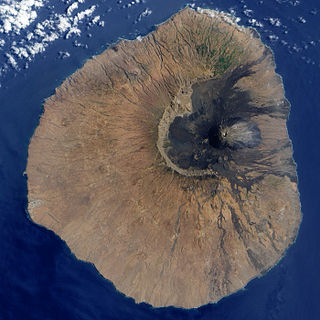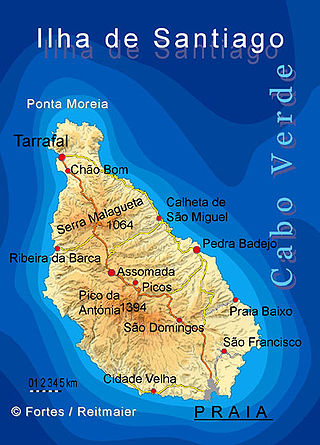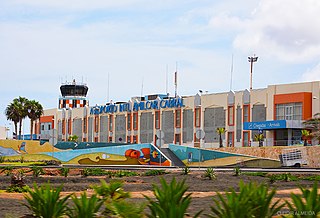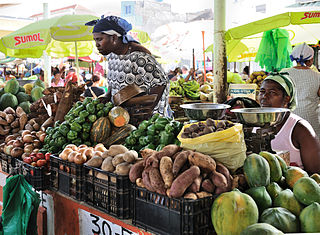| |||||
| Decades: | |||||
|---|---|---|---|---|---|
| See also: | |||||
The following lists events that happened during 1939 in Cape Verde .
| |||||
| Decades: | |||||
|---|---|---|---|---|---|
| See also: | |||||
The following lists events that happened during 1939 in Cape Verde .
Most transportation in Cape Verde is done by air. There are regular flights between the major islands, with less frequent flights to the other islands. Boat transportation is available, though not widely used nor dependable. In the major cities, public bus transport runs periodically, and taxis are common. In smaller towns, there are mostly hiaces and/or taxis.

Fogo is an island in the Sotavento group of Cape Verde in the central Atlantic Ocean. Its population is 35,837 (2015), with an area of 476 km2. It reaches the highest altitude of all the islands in Cape Verde, rising to 2,829 metres above sea level at the summit of its active volcano, Pico do Fogo.

Sal is an island in Cape Verde. Sal is a tourist destination with white sandy beaches and over 350 days of sunshine a year. It is one of the three sandy eastern islands of the Cape Verde archipelago in the central Atlantic Ocean, 350 mi (560 km) off the west coast of Africa. Cabo Verde is known for year-round kiteboarding, for the large reserve of Caretta turtles which hatch from July to September, and the music of Cesaria Evora.

Cabo Verde Airlines is an international airline based in Cape Verde. It connects three continents with non-stop flights from their hub at Amílcar Cabral International Airport on Sal Island.

Boa Vista, sometimes incorrectly spelled Boavista, is a desert-like island that belongs to the Cape Verde Islands. At 631.1 km2 (243.7 sq mi), it is the third largest island of the Cape Verde archipelago.

Santiago is the largest island of Cape Verde, its most important agricultural centre and home to half the nation's population. Part of the Sotavento Islands, it lies between the islands of Maio and Fogo. It was the first of the islands to be settled: the town of Ribeira Grande was founded in 1462. Santiago is home to the nation's capital city of Praia.
Binter Canarias S.A. is the flag carrier of the Spanish autonomous community of the Canary Islands, based on the grounds of Gran Canaria Airport in Telde, Gran Canaria and Tenerife North Airport, San Cristóbal de La Laguna, Spain. It is a regional air carrier operating inter-island services within the Canary Islands, and other Atlantic islands, it also operates to the Spanish Mainland and some European destinations, mainly in France and Italy. Affiliated airlines operate on behalf of Binter in services to Morocco, mainland Spain, Portugal.

Espargos is the capital and main commercial centre of the island and municipality of Sal, Cape Verde. The city is situated in the heart of the island.

Amílcar Cabral International Airport, also known as Sal International Airport, is the main international airport of Cape Verde. The airport is named after the revolutionary leader Amílcar Cabral. It is located two km west-southwest from Espargos on Sal Island. Sal is the main hub for the national airline, Cabo Verde Airlines; and serves as a base for carrier Cabo Verde Express. This airport was also one of NASA's locations for a facility to handle the Space Shuttle after reentering from orbit.

Nelson Mandela International Airport, also known as Praia International Airport, is the airport of Santiago Island in Cape Verde. It was opened in October 2005, replacing the old Francisco Mendes International Airport. It is located about 3 km northeast of the city centre of Praia in the southeastern part of the island of Santiago.

Cesária Évora Airport is Cape Verde's fourth-busiest airport, located on the island of São Vicente, nearly 5 kilometres (3.1 mi) from the centre of Mindelo. It is located in the valley area in the west of the island and is north of the village of São Pedro. Its runway is 2,000 metres (6,600 ft) long and its width is 45 metres (148 ft)

Rabil is a town on the island of Boa Vista, Cape Verde. It was the island's former capital. Rabil is the island's second largest town, located 6 kilometres (3.7 mi) southeast of the island capital of Sal Rei. Its population was 1,248 in 2010. The island's airport, Aristides Pereira International Airport, is situated northwest of the town.

Aristides Pereira International Airport is an airport in Cape Verde located on the island of Boa Vista, about 5 km (3.1 mi) southeast of the island capital Sal Rei. It is the third-busiest airport in the country.

The following outline is provided as an overview of and topical guide to Cape Verde:

The economy of Cape Verde is a service-oriented economy that is focused on commerce, trade, transport and public services. Cape Verde is a small archipelagic nation that lacks resources and has experienced severe droughts. Agriculture is made difficult by lack of rain and is restricted to only four islands for most of the year. Cape Verde's economy has been steadily growing since the late 1990s, and it is now officially considered a country of average development, being only the second African country to have achieved such transition, after Botswana in 1994. Cape Verde has significant cooperation with Portugal at every level of the economy, which has led it to link its currency first to the Portuguese escudo and, in 1999, to the euro.

Cape Verde or Cabo Verde, officially the Republic of Cabo Verde, is an archipelago and island country of West Africa in the central Atlantic Ocean, consisting of ten volcanic islands with a combined land area of about 4,033 square kilometres (1,557 sq mi). These islands lie between 600 and 850 kilometres west of Cap-Vert, the westernmost point of continental Africa. The Cape Verde islands form part of the Macaronesia ecoregion, along with the Azores, the Canary Islands, Madeira and the Savage Isles.

Achada Grande Tras is a subdivision of the city of Praia in the island of Santiago, Cape Verde. Its population was 2,958 at the 2010 census. It is situated east of the city centre, and south of the Nelson Mandela International Airport. Adjacent neighbourhoods include Achada Grande Frente and Lem Ferreira to the west.